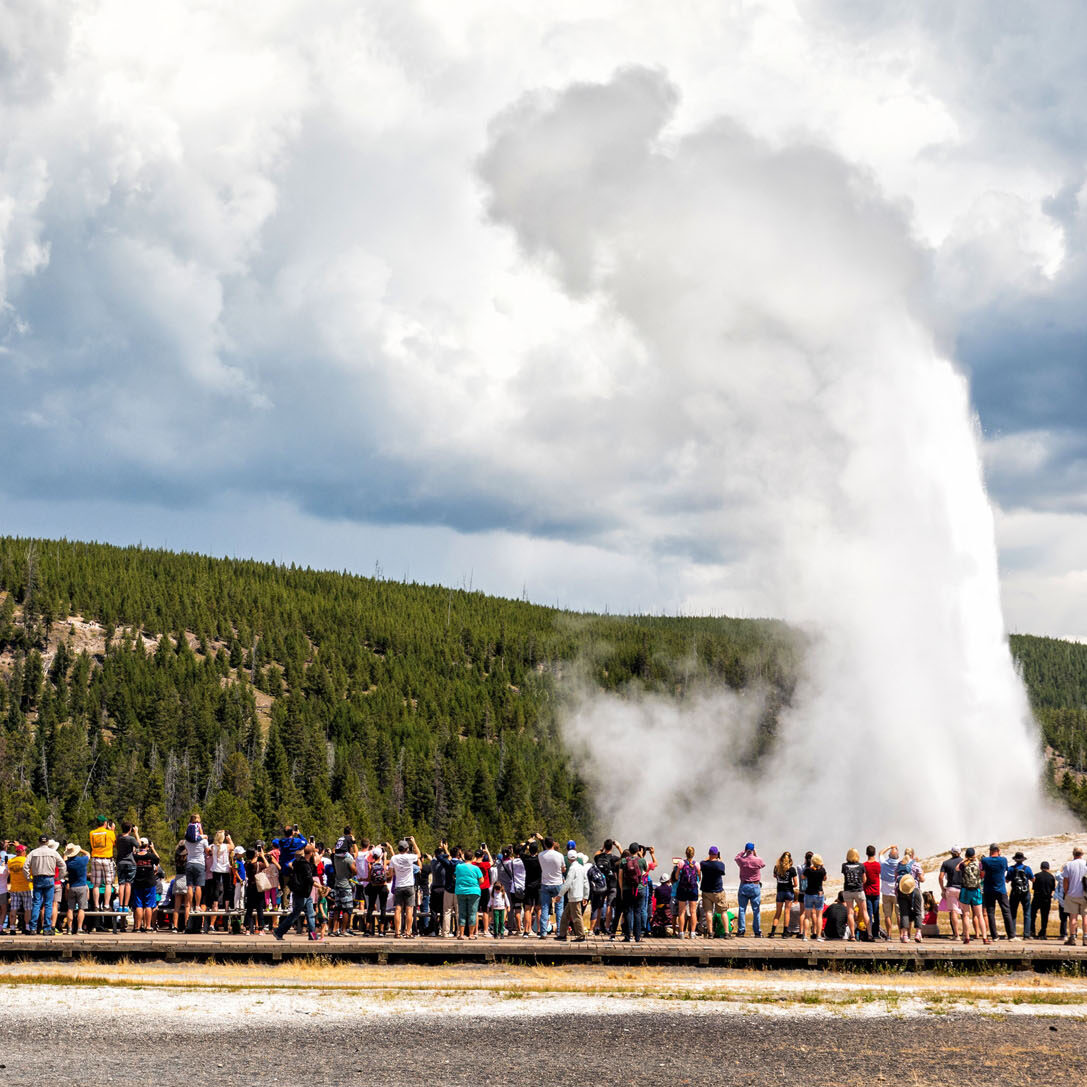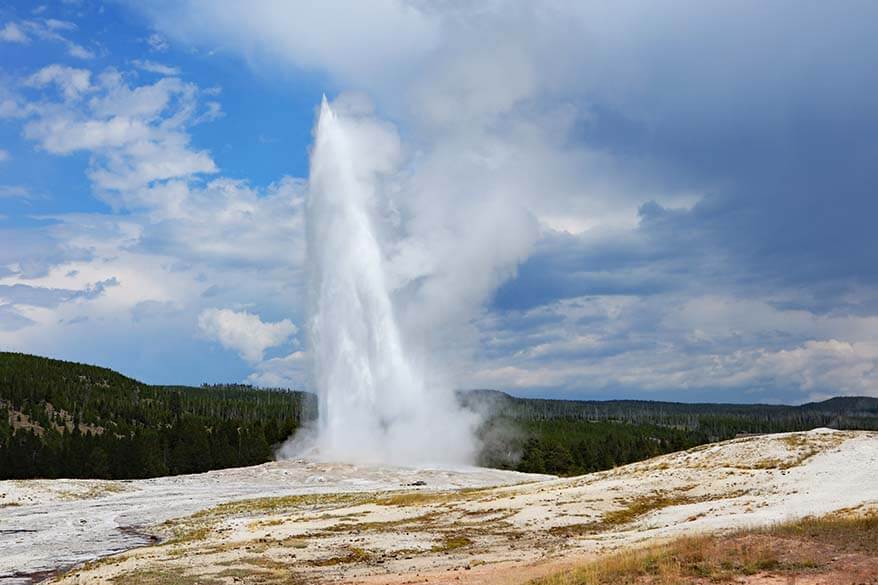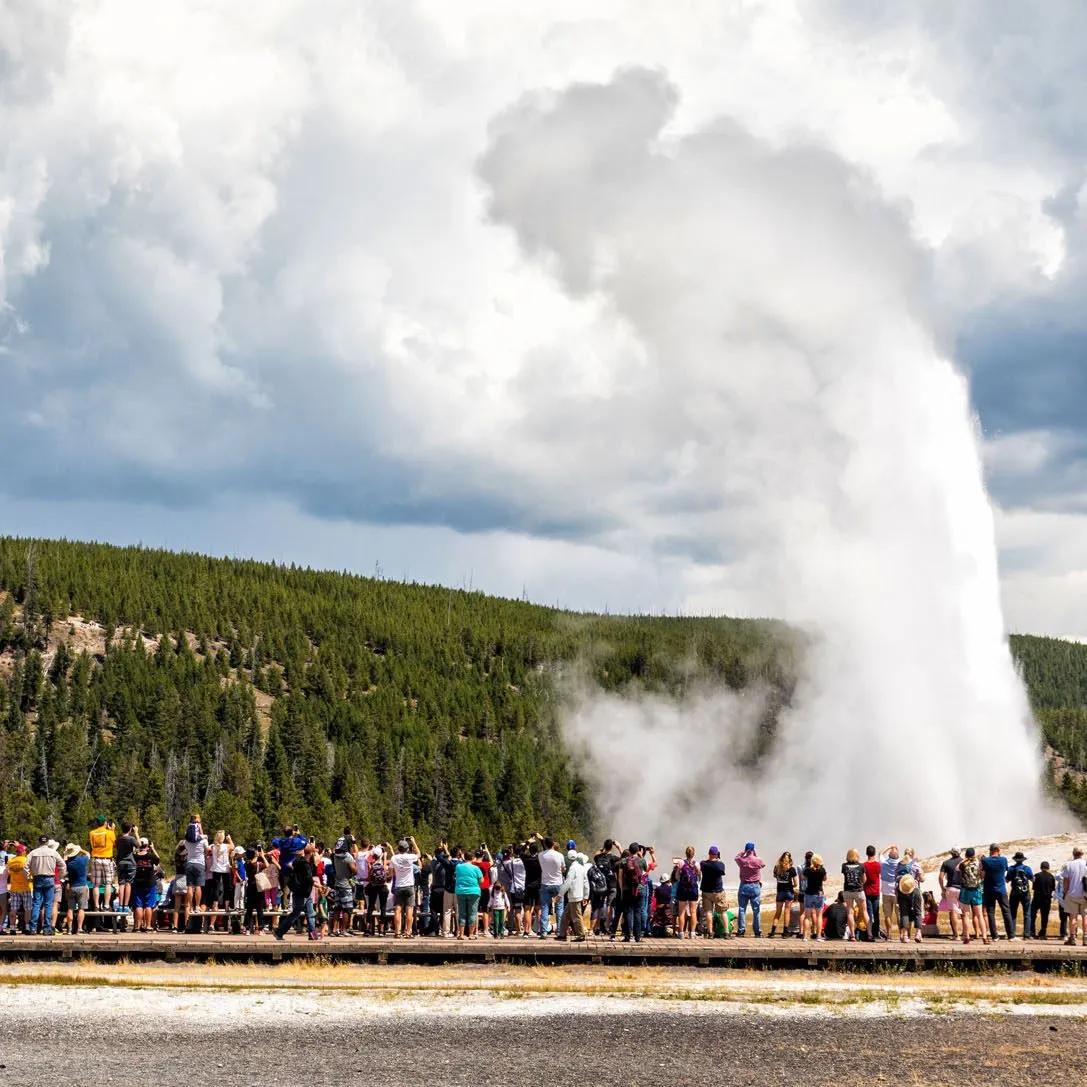Planning your Yellowstone geyser adventure? After spending countless hours studying eruption patterns and visiting during different seasons, I've discovered the optimal times to witness these natural wonders without the massive crowds. This comprehensive guide reveals the best time to see geysers in Yellowstone based on seasonal conditions, daily timing, and insider strategies that most visitors miss. Visit our homepage for more expert travel guides.

Old Faithful during optimal viewing conditions - fewer crowds, perfect lighting
Spring: Peak Wildlife and Emerging Geysers (April-June)
Why Spring is Ideal for Geyser Viewing
Spring represents one of the most rewarding seasons for experiencing the best time to see geysers in Yellowstone. During my April visits, I've consistently found that most roads reopen by mid-April, providing access to major geyser basins while maintaining significantly lower visitor numbers compared to summer months.
The thermal features become particularly photogenic during spring mornings when cool air creates dramatic steam plumes around geysers. Visiting Yellowstone in May offers the perfect balance of accessibility and manageable crowds, making it an excellent choice for serious geyser enthusiasts.
Temperature variations during spring (ranging from 19°F to 80°F depending on elevation and month) create optimal conditions for geyser visibility. The contrast between hot springs and cool air produces enhanced steam effects, making eruptions more visually dramatic. Additionally, spring wildlife viewing coincides perfectly with geyser tours, as animals emerge from winter habitats.
Spring Geyser Viewing Advantages
- Dramatically fewer crowds: 60-70% less congested than peak summer
- Enhanced visibility: Cool air creates spectacular steam plumes
- Wildlife bonus: Bears, elk, and bison are highly active
- Photography opportunities: Optimal lighting conditions for capturing eruptions
- Weather variability: Brings unique atmospheric conditions to geyser basins
Spring Weather Considerations: Pack layers and waterproof gear. Weather can change rapidly, and some higher elevation areas may still have snow. Check Yellowstone weather patterns before your visit.
Summer: Peak Activity with Strategic Timing (July-August)
Summer months present both the greatest opportunities and biggest challenges for geyser viewing. While July in Yellowstone offers the most predictable weather and fullest park access, it also brings peak crowd levels that can significantly impact your experience.
Managing Summer Crowds at Geyser Basins
During my July visits, I've learned that timing is absolutely critical. The Upper Geyser Basin (home to Old Faithful) can become overwhelmingly crowded between 9 AM and 4 PM. However, arriving before 8 AM or after 6 PM reveals a completely different experience – one where you can actually hear the geysers and move freely around viewing areas.
The key insight most visitors miss is that geysers don't follow human schedules. Old Faithful erupts approximately every 94 minutes regardless of crowd levels, meaning early morning and evening eruptions are just as spectacular as midday ones – but with 80% fewer spectators. Understanding crowd patterns can transform your summer geyser experience.
Summer Geyser Viewing Strategy
Optimal Daily Schedule
- • 6:00-8:00 AM: Upper Geyser Basin tour
- • 8:30-10:00 AM: Grand Prismatic viewing
- • 10:00 AM-4:00 PM: Avoid major geyser areas
- • 6:00-8:00 PM: Return for evening eruptions
Alternative Geyser Locations
- • Norris Geyser Basin: Less crowded, active features
- • Lower Geyser Basin: Great Fountain Geyser
- • West Thumb: Lakeside thermal features
- • Midway Basin: Grand Prismatic alternatives

Upper Geyser Basin during golden hour - the difference timing makes
Fall: Optimal Conditions with Fewer Crowds (September-October)
Fall emerges as the secret weapon for serious geyser enthusiasts. September visits to Yellowstone combine the accessibility of summer with the crowd levels of spring, creating ideal conditions for extended geyser observation.
During my September visits, I've witnessed some of the most spectacular geyser displays, enhanced by crisp autumn air that creates dramatic steam contrasts. The cooler temperatures also make waiting for unpredictable geysers like Grand Geyser much more comfortable – something that's challenging during hot summer afternoons.
What makes fall particularly special is the extended daylight hours still available in September, combined with peak fall foliage that provides stunning backdrops for geyser photography. The thermal features seem more prominent against the colorful landscape, creating unique viewing opportunities not available during other seasons.
Why Fall Represents the Best Time to See Geysers in Yellowstone
Perfect Temperature Balance
Cool mornings enhance steam visibility while comfortable daytime temperatures allow extended observation periods.
Minimal Crowds
Post-Labor Day visitor numbers drop dramatically, providing intimate geyser viewing experiences.
Enhanced Photography
Autumn colors create stunning contrasts with white steam plumes and blue thermal pools.
Extended Viewing Opportunities
Comfortable weather allows patients waiting for irregular geysers like Beehive or Grand Geyser.
Fall Planning Tip: Book accommodations early for September visits, as many experienced visitors know this is the optimal season. Consider seasonal road closures that begin in early November.
Winter: Unique Snow-Covered Geyser Experience (November-March)
Winter geyser viewing in Yellowstone offers an otherworldly experience that few visitors ever witness. While access is limited to the northern entrance and specific areas, those who venture into the park during winter months discover geysers in their most dramatic setting – surrounded by snow and ice, creating ethereal steam clouds against pristine white landscapes.
Winter Geyser Accessibility and Logistics
During winter months, only the road between Gardiner, Montana (north entrance) and Cooke City remains open for regular vehicles. However, this limitation actually enhances the geyser viewing experience by providing access to Mammoth Hot Springs and some of the most reliable thermal features without any crowds whatsoever.
Snowcoach and snowmobile tours provide access to Old Faithful and other major geyser basins, offering a completely unique perspective on these thermal wonders. The contrast between sub-zero air temperatures and 200°F+ geyser water creates some of the most dramatic steam displays possible.
Winter also provides excellent opportunities to observe how thermal features create their own microclimates. Snow melts in perfect circles around hot springs, and wildlife congregates near thermal areas for warmth, creating unique viewing opportunities where animal behavior intersects with geothermal activity.
Winter Geyser Viewing Considerations
Challenges
- • Limited road access (north entrance only)
- • Extreme cold temperatures (-20°F to 20°F)
- • Shorter daylight hours
- • Need for specialized winter gear
- • Higher costs for snowcoach tours
Unique Benefits
- • Zero crowds at viewing areas
- • Maximum steam effect visibility
- • Pristine snow-covered landscapes
- • Wildlife concentrated near thermal areas
- • Once-in-a-lifetime photography opportunities
Daily Timing Strategy: Beat the Crowds
Understanding daily crowd patterns is crucial for optimizing your geyser viewing experience. Based on extensive observation and ranger insights, certain times of day consistently provide superior viewing conditions regardless of season.
The Golden Hours for Geyser Viewing
Dawn (6:00-8:00 AM)
Minimal crowds, enhanced steam visibility, peaceful atmosphere
Late Afternoon (4:00-6:00 PM)
Crowds begin dispersing, optimal lighting for photography
Evening (6:00-8:00 PM)
Dramatic lighting, intimate viewing experience, cooler temperatures
Times to Avoid for Optimal Geyser Experience
- 9:00 AM - 11:00 AM: Tour groups arrive, parking becomes challenging
- 12:00 PM - 3:00 PM: Peak crowd density, limited viewing space
- Weekend afternoons: Highest visitor concentration
Pro Timing Strategy
The most successful geyser enthusiasts I've met follow a "sandwich" approach: they arrive at geyser basins during off-peak hours, spend the busy midday period exploring less crowded areas or taking breaks, then return for evening viewing sessions.
This strategy is particularly effective at Old Faithful, where you can check eruption predictions at the visitor center during busy periods, then time your return for the next predicted eruption during a quieter time window.
My Personal Geyser Viewing Experience
During my first Yellowstone visit in July 2019, I made every rookie mistake possible. I arrived at Old Faithful at 2 PM on a Saturday, spent 45 minutes looking for parking, and then watched the eruption surrounded by hundreds of other tourists. The experience, while still magical, felt more like attending a crowded sporting event than connecting with nature.
My September 2021 return visit was a completely different story. Armed with research and ranger recommendations, I arrived at the Upper Geyser Basin at 6:30 AM. The parking lot was nearly empty, mist hung low over the thermal features, and when Old Faithful erupted at 7:15 AM, fewer than 20 people witnessed it. The difference was transformational – I could actually hear the water bubbling before the eruption and feel the ground vibrations.
That morning taught me that timing isn't just about convenience – it's about accessing the true spirit of these geological wonders. Since then, I've visited Yellowstone during all four seasons, and each has offered unique geyser viewing rewards that inform the recommendations in this guide.
Lessons Learned from Multiple Visits
Weather Enhances Geyser Drama
Cool mornings create the most dramatic steam effects. My best geyser photos were taken during 40°F mornings when the contrast between hot water and cold air was maximum.
Patience Pays Off
Waiting 45 minutes for Grand Geyser during an uncrowded September afternoon gave me a front-row view of one of Yellowstone's most spectacular eruptions – something impossible during peak hours.
Explore Beyond Old Faithful
Norris Geyser Basin offered equally impressive thermal features with 90% fewer visitors. Steamboat Geyser, when active, is more spectacular than Old Faithful.
Expert Geyser Viewing Guide
Comprehensive guide to Yellowstone's most spectacular geysers
Essential Gear for Geyser Viewing
Having the right equipment can dramatically enhance your geyser viewing experience. From wildlife observation to weather protection, these carefully selected items will ensure you're prepared for any conditions Yellowstone presents.

The Geysers of Yellowstone: Sixth Edition
$22.63
Essential field guide describing over 500 geysers with detailed maps, eruption patterns, and geological insights. Perfect for serious geyser enthusiasts.
View on Amazon
Occer 12x25 Compact Binoculars
$27.53 $35.99
Perfect for wildlife viewing around geyser basins. Compact, waterproof design ideal for spotting elk, bison, and bears near thermal features.
View on Amazon
Compass American Guides: Yellowstone
$12.99 $22.99
Comprehensive full-color travel guide with detailed maps, hiking trails, and insider tips for both Yellowstone and Grand Teton National Parks.
View on Amazon
12x42 HD Binoculars with Phone Adapter
$29.99
Professional-grade binoculars with smartphone adapter for photographing distant wildlife and geyser eruptions. Includes tripod mounting capability.
View on Amazon
Yellowstone Travel Guide 2025
$16.99
Ultimate 2025 trip planner with scenic drives, hiking trails, wildlife spotting guides, geyser information, and camping recommendations with color images.
View on AmazonWhat Users Are Saying
"The Geysers of Yellowstone book was invaluable during our September visit. We used it to find less crowded thermal features and understand eruption patterns. Worth every penny!" - Amazon Reviewer
"Compact binoculars were perfect for wildlife viewing around Old Faithful. Spotted a family of elk that other tourists missed completely." - Reddit User
"Used the HD binoculars with phone adapter to capture amazing shots of Grand Geyser erupting. The quality surprised me for the price point." - Quora Response
Expert Tips from Park Rangers
During my conversations with Yellowstone park rangers and geyser specialists, several consistent themes emerged about optimizing geyser viewing experiences. These professional insights, combined with observations from seasoned "geyser gazers," form the foundation of advanced viewing strategies.
Understanding Thermal Dynamics
Rangers emphasize that geyser activity fluctuates with seasonal groundwater levels and barometric pressure changes. Spring snowmelt increases underground water pressure, often leading to more frequent eruptions.
Monitor weather patterns – low pressure systems can trigger increased geyser activity, while high pressure may reduce eruption frequency.
Geyser Gazer Communication
Experienced visitors use FRS radios set to channel 4.5 to share eruption reports throughout geyser basins. This network helps predict irregular geysers like Grand and Beehive.
Check the visitor center for current geyser prediction updates, as ranger staff maintain detailed eruption logs updated throughout the day.
Advanced Viewing Strategies
Position Selection
Rangers recommend positioning yourself downwind from geysers when possible to avoid steam obstruction. For Old Faithful, the benches on the north side provide optimal viewing angles for photography.
Patience Strategy
Professional geyser gazers often arrive 30-45 minutes before predicted eruption times for unpredictable geysers. This patience is rewarded with prime viewing positions and the full eruption experience.
Alternative Locations
Rangers suggest exploring Fountain Paint Pot and Artists Paint Pots during peak hours at Old Faithful. These areas offer equally impressive thermal features with minimal crowds.

Strategic positioning for optimal geyser viewing experience
Safety Reminders from Rangers
- • Always stay on designated boardwalks and trails around thermal features
- • Maintain minimum 25-yard distance from all wildlife, 100 yards from bears and wolves
- • Carry bear spray when hiking to remote geyser locations
- • Check current road conditions before planning your route
- • Pack layers for temperature variations, especially during shoulder seasons
Frequently Asked Questions
What is the absolute best time to see geysers in Yellowstone without crowds?
The optimal time combines seasonal and daily timing: early September mornings between 6:00-8:00 AM offer the perfect balance of accessibility, weather conditions, and minimal crowds. During this window, you'll experience dramatic steam effects from cool morning air while having prime viewing positions at major geysers like Old Faithful. Fall's comfortable temperatures also allow patience for irregular geysers like Grand Geyser, which offers spectacular eruptions but unpredictable timing. This timeframe consistently provides the most rewarding geyser viewing experience based on multiple seasonal visits and ranger recommendations.
Do geysers erupt more frequently during certain seasons?
Geyser eruption frequency can vary with seasonal groundwater levels and barometric pressure changes. Spring snowmelt typically increases underground water pressure, potentially leading to more frequent eruptions at some geysers. However, major geysers like Old Faithful maintain relatively consistent intervals year-round (approximately every 94 minutes). The more noticeable seasonal difference is visibility and accessibility rather than frequency. Winter creates the most dramatic steam displays due to temperature contrasts, while summer offers the most comfortable viewing conditions but with significantly larger crowds during peak eruption times.
How far in advance should I plan my Yellowstone geyser viewing trip?
For optimal geyser viewing experiences, plan 6-12 months in advance, especially for September visits when conditions are ideal but accommodations fill quickly. Spring visits (April-May) require 3-6 months advance planning due to limited lodging availability as facilities reopen. Summer planning should begin 12+ months ahead for premium locations near geyser basins. Winter geyser viewing via snowcoach tours requires 2-3 months advance booking. Regardless of season, check monthly park conditions and book lodging before finalizing specific geyser viewing itineraries, as accommodation availability often determines optimal visit timing more than seasonal preferences.
What should I bring for optimal geyser viewing and photography?
Essential geyser viewing equipment includes layers for temperature variations (thermal areas can be 10-15°F warmer than surrounding areas), waterproof footwear for boardwalks that may be wet from steam, and quality binoculars for wildlife observation around thermal features. For photography, bring a tripod for low-light conditions during optimal morning/evening viewing times, lens cleaning cloths for steam condensation, and extra batteries as cold weather drains power quickly. Pack sunscreen regardless of season due to high altitude UV exposure, and consider bringing a portable chair for comfortable waiting during irregular geyser eruptions. Most importantly, bring patience and flexible timing – the best geyser experiences reward those willing to adapt their schedule to natural patterns rather than forcing rigid itineraries.
Are there reliable ways to predict when geysers will erupt?
Only a few Yellowstone geysers have predictable eruption patterns, with Old Faithful being the most reliable (approximately every 94 minutes, ±10 minutes). Rangers provide predictions for Castle, Daisy, Grand, Riverside, and Great Fountain geysers based on historical patterns and recent activity, available at visitor centers and through the official NPS Yellowstone app. However, most of Yellowstone's 500+ geysers are completely unpredictable. Experienced "geyser gazers" use FRS radios (channel 4.5) to share eruption reports and coordinate viewing opportunities for irregular geysers. The GeyserTimes.org website also provides crowdsourced eruption data and predictions. While prediction science continues advancing, embracing the unpredictability enhances the authentic wilderness experience – some of the most memorable geyser encounters happen completely by chance during patient exploration of thermal basins.
Conclusion
Discovering the best time to see geysers in Yellowstone requires balancing multiple factors: seasonal accessibility, daily crowd patterns, weather conditions, and personal preferences. Through extensive research and firsthand experience across all four seasons, the evidence consistently points to early fall mornings as the optimal window for geyser viewing.
September combines summer's accessibility with spring's manageable crowds, while cool morning temperatures enhance the dramatic steam effects that make geyser eruptions truly spectacular. Whether you're photographing Old Faithful's reliable eruptions or patiently waiting for Grand Geyser's unpredictable magnificence, timing your visit during off-peak hours transforms the experience from crowded spectacle to intimate natural wonder.
Remember that each season offers unique rewards: spring's wildlife emergence, summer's comfortable conditions, fall's perfect balance, and winter's otherworldly beauty. The key is matching your priorities with seasonal advantages while always prioritizing early morning or evening visits to minimize crowds and maximize the authentic Yellowstone experience.
Ready to Plan Your Perfect Geyser Adventure?
Use our expert recommendations to create unforgettable Yellowstone memories. Check out more seasonal guides and insider tips.
Explore More Guides

